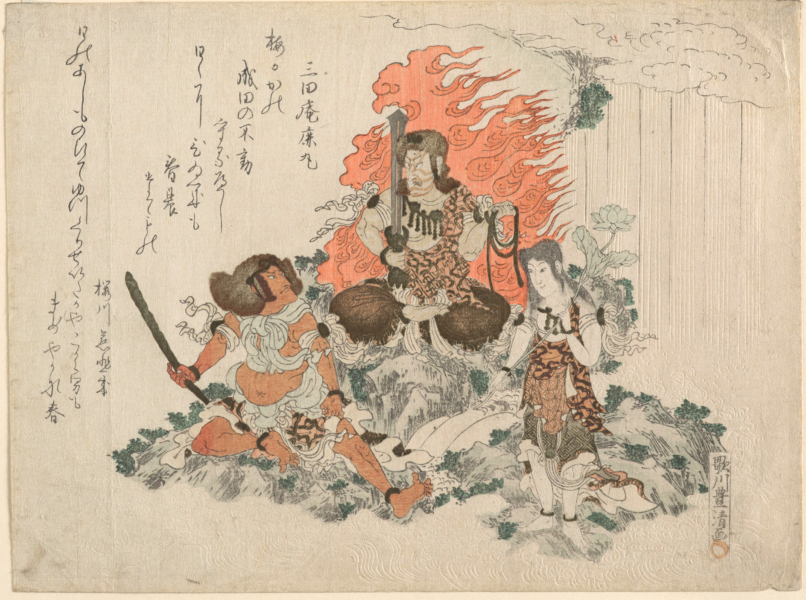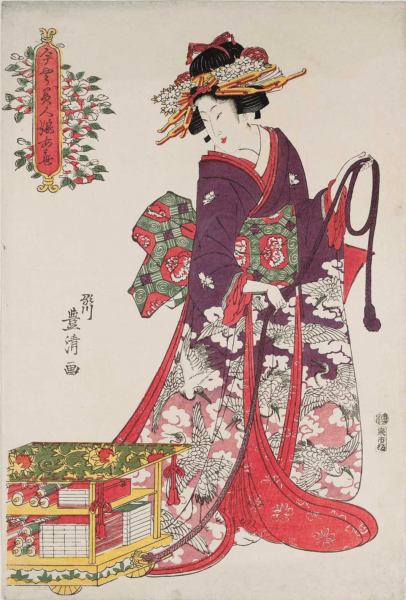Although I had seen the name of Utagawa Toyokiyo 歌川豊清, and even on various occasions, I never bothered to find out who he really was. But working occasionally on the collection of the Museum of East Asian Art at Cologne, I was intrigued by a quite impressive surimono print that he designed at the age of only 14.

Museum für Ostasiatische Kunst, Cologne (R 63,3)
Toyokiyo was born in 1799, the son of Utagawa Toyohiro 歌川豊広 – as Yoshida Teruji’s still unsurpassed Ukiyoe jiten tells me. Studying at first with his father and also with Utagawa Toyokuni 歌川豊国, his early work is signed Kinzō 金蔵. As he just turns fourteen – others would then just start their professional training – Utagawa Toyoharu 歌川豊春 gives him the art-name of Toyokiyo.
His earliest known work, signed Utagawa Kinzō, dates from 1810, the illustrations of a 3-volume novel by Tōzaian Nanboku 東西庵南北 (died 1827), also known as Rokkyokuen 六極園, a judge of the Gogawa poetry club. This novel, Fudehajime hinode matsu 筆始日出松 (NSN 388; KSM 7:116-2), is only one of eleven novels that Nanboku published that year. Of these, six are illustrated by Katsukawa Shunsen 勝川春扇, three by Utagawa Kunifusa 歌川国房, and one each by Utagawa Kunisada 歌川国貞 and Utagawa Toyokiyo. The collaboration is repeated two years later, in 1812, when Toyokiyo illustrates a 5-volume novel by Nanboku, the Onna kappō koi no shugyōsha 女合法恋修業者 (NSN 397; KSM 1:715-2). He then signs ‘Kinzō aratame Toyokiyo,’ thus announcing his change of name.
In the same year, Toyokiyo is selected also for a much more prestigious job, to make the illustrations for Kyokutei Bakin’s 曲亭馬琴 (1767-1848) novel Itozakura shunchō kien 糸桜春蝶奇緑 (NSN 106; KSM 1:266-1) in ten volumes, which was apparently reissued in 1826 and 1854.
Otherwise, in the medium of prints, we know of a series of Ōmi hakkei 近江八景 with the views in medallions, signed Utagawa Kinzō 哥川金蔵, all eight chūban 中判 prints known (MFA Boston Res. 49.130-137). He also makes a rather simple print of the Korean envoy that came to Edo in III/1811, titled Chōsenjin raichō gyōretsu no zu 朝鮮人来朝行列図 (The Procession of the Korean Envoy to Japan, a copy of which is preserved in the Tokyo Metropolitan Library). And then there is, also mentioned by Yoshida, his series of ōban 大判 prints titled Imayō bijin musume awase 今様美人娘合 (Todays Beautiful Women and Girls) published by Izumiya Ichibei. Yoshida has a small illustration of a woman holding a child playing with a toy, and dates the series to around 1812, which is indeed quite likely. Another print from this series, of a woman holding the cord of a wheeled book-cart (fuguruma 文車), in the Boston collection again (11.18022), offers a better opportunity to appreciate Toyokiyo’s talents. It is not only an extremely well-preserved print in quite stunning colours, it is also quite a powerful design. Indeed, for a boy just fourteen years old, this would herald a great future.

(Museum of Fine Arts, Boston)
But before we come to speak of that, let’s focus on one more design, the surimono I mentioned earlier. Against the backdrop of a wide waterfall, we see the actor Ichikawa Danjūrō VII 七世市川団十郎 (1791-1859) as Fudō Myōō 不動明王, the God of the Waterfalls. To the right of him is Iwai Hanshirō V 五世岩井半四郎 (1776-1847) als Seitaka Dōji せいたか童子 holding a lotus, and to the left Matsumoto Kōshirō V 五世松本幸四郎 (1764-1838) as Kongara Dōji こんから童子 swaying a club. As Danjūrō impersonated the role of Fudō only once during the period of Toyokiyo’s activity, the play is easily identified as Yuki mo Yoshino kigoto no kaokagami 雪吉野恵木顔鏡, staged XI/1812 in the Morita Theatre 森田座 (KN 5:507). With two poems above, one by Mitaan Shikamaru 三田庵鹿丸, the other by Sakuragawa Jihinari 桜川慈悲成 (1760-1833), this was a perfect New Year’s card for the year 1813.
Naturally, we know that Jihinari was a good friend of both Toyohiro, the father of Toyokiyo, and of Danjūrō. Yet, it is quite amazing that they would offer the fourteen year old Toyokiyo the chance to design such a prestigious surimono in quite a large format. This confirms that he was widely – and justifiably – considered a promising talent. Then there is, discussed by William Green in a 1985 issue of the Ukiyo-e Society of America’s Impressions titled “Reflections and random notes on an uncommon surimono,” he informs us of his recent acquisition of a collaborative work of father and son, Toyohiro making a design of three karako playing with a kite, and Toyokiyo painting the kite with a large-head portrait of Danjūrō in Shibaraku. This would probably make a companion print to the Cologne surimono, as it would seem to be based on Danjūrō performing Shibaraku in his role of Shinozuka the Lord of Iga 篠塚伊賀守 in the same play in XI/1812. Somewhat later, most likely based on a performance of Shikisemono Soga datezome 例燭曽我伊達染 in I/1813 at the Morita Theatre 森田座 (KN 5:511), there are two quite similar surimono prints with a portrait of an actor as if it were a mounted scroll painting, one of Ichikawa Danjūrō VII 七世市川団十郎 as Soga no Gorō in Yanone 矢の根五郎 (his spear sharpening act, though not explicitly mentioned in Kabuki nenpyō)*, the other with Matsumoto Kōshirō IV 松本幸四郎 as Kudō Suketsune 工藤祐經. Both prints have three poems, the last ones again by Sakuragawa Jihinari. And then, until his untimely death in 1820 at the age of 22, there is no more trace of any activity, no book illustrations, no more prints, no more surimono, nothing.
What happened? Bakin’s recollections in his Kinsei mono no hon 近世物之本 make no mention of Toyokiyo. The Ukiyoe ruikō 浮世絵類考 confirms that he was the son of Toyohiro and initially trained by both his father and Toyokuni. Another version states that he ‘made many prints and novels, and one or two yomihon’ 錦繪草双子等多く読本一二部あり. And the Watanabe version of the Ruikō mentions a New Year’s surimono of Danjūrō in Shitennō 四天王 for 1804, maybe a bit unlikely for a boy six years old. Indeed, this would more likely be after the performance of XI/1810 at the Ichimura Theatre 市村座 with Danjūrō playing Kidōmaru 鬼同丸. Would love to see it, would still be signed Utagawa Kinzō. Or would it be that his father Toyohiro figured that it was about time that he should learn some craft, as was normal practice for Japanese boys at the time. Ukiyo, the Floating World, is what we can see through pink glasses, La Vie en Rose, but there is also a very harsh reality … erst kommt das Fressen …
* In the Museum für Kunst und Gewerbe, Hamburg (S2012774.1, from the collection of my good old friend Gerhard Schack)